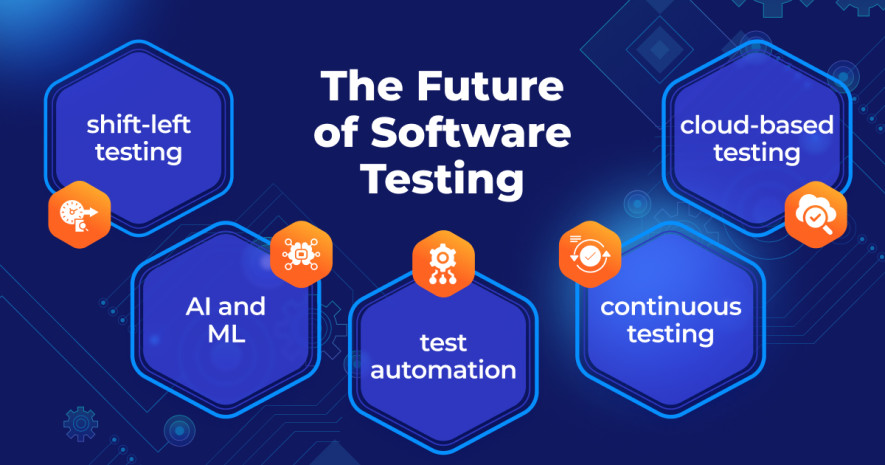- QATestLab Blog >
- QA for Business >
- Industries Insights >
- Software Testing in 2024: Innovations and Transformations
Software Testing in 2024: Innovations and Transformations

Imagine the software development landscape in 2024, where software testing is not just a task but a crucial adventure in the development journey. According to the report, the software testing market size exceeded more than $47 billion in 2023 and is anticipated to cross $103.5 billion by 2033. Therefore, the software testing market is booming and has transcended its role from a final check to a key player in crafting successful software. This growth is not just numerical; it reflects a more profound shift in methodologies, technologies, and mindsets.
Today, we delve into some of the most promising trends that are shaping the future of software testing: from the proactive approach of shift-left testing to the cutting-edge applications of AI and ML, the seamless process of continuous testing, the efficiency of test automation, and the scalability of cloud-based solutions. Each of these trends presents an opportunity for organizations to elevate the quality of their software products, streamline their testing processes, and ultimately deliver solutions that meet and exceed market and user expectations.
We are entering an era of smart testing, where AI, cloud technology, and innovative practices are changing the game. This is not just about finding bugs now. It stands for building testing excellence. Let’s explore these exciting trends that are shaping our digital future.
Shift-Left Testing: A Proactive Approach in Software Development
Shift-left testing marks a paradigm shift in software testing, starting at the earliest stage in the development cycle. This approach mitigates the risk of late-stage defects and significantly curtails costs that are connected to fixing errors discovered late in the process. By embedding testing into the earliest stages of development, shift-left fosters a proactive testing culture, ensuring that defects are identified and resolved when they are least expensive and disruptive to address.
Implementing shift-left testing seamlessly blends with continuous integration and delivery pipelines, offering immediate feedback on code changes. This strategy allows developers to rectify issues promptly, enhancing the software’s quality and expediting its time-to-market. Moreover, involving testers from the onset deepens their understanding of the software’s requirements and design, enabling them to identify potential problems early on.
This trend underscores a collaborative synergy between developers and testers, eradicating silos and fostering a unified goal of delivering high-quality software efficiently. As a strategic component of modern software development, shift-left testing is pivotal for organizations aiming to streamline their development process and achieve excellence in their software products.
Using AI and ML for Enhanced Software Testing
The integration of Artificial Intelligence (AI) and Machine Learning (ML) in software testing is revolutionizing the field, bringing in unprecedented efficiency and precision. AI and ML automate repetitive tasks like regression testing, enabling testers to focus on more complex challenges. This automation extends to generating test cases and data, improving test coverage, and reducing human error.
Beyond automation, AI and ML are instrumental in predicting defects. By analyzing data from past tests, these technologies can identify patterns and anomalies indicative of potential issues. This predictive capability allows testers to concentrate on the most defect-prone areas, enhancing the effectiveness of the testing process.
Moreover, AI and ML facilitate testing at scale, handling extensive arrays of test cases and data sets that would be unmanageable manually. Their ability to learn and evolve over time means that these systems become more efficient and accurate in defect detection, continually enhancing the testing process. You can learn more about AI and Machine Learning (ML) in our latest article.
The use of AI and ML in software testing is a transformative shift that is setting new standards for quality and efficiency in software development.
Continuous Testing: Ensuring Reliability in Real-Time
Continuous testing marks a crucial evolution in the software testing arena. It integrates testing into the continuous integration and delivery pipeline, ensuring that every code change undergoes testing before deployment. This approach aligns perfectly with modern rapid development practices, where the pace of code releases is brisk and constant.
The primary advantage of continuous testing is its ability to detect defects promptly, reducing the cost and effort of late-stage fixes. Automating and running tests in parallel allows for extensive coverage even in tight development schedules. This ensures code quality and fosters a collaborative environment where developers and testers work together towards a common goal of faultless, efficient code deployment.
Continuous testing is responsible for ensuring that software products are reliable and market-ready at all times.
Test Automation: Streamlining Efficiency in Software Testing
Test automation has become a cornerstone of modern software testing strategies. It automates repetitive and labor-intensive tasks, significantly improving testing efficiency and accuracy. Key application areas include regression testing, functional testing, and performance testing. By leveraging automation, testers can run tests more frequently and on a larger scale than manual testing allows, enhancing overall test coverage and early defect identification.
Automation tools in software testing are really flexible. They work with different kinds of tests, including unit tests, integration tests, and full-system tests. When they’re combined with continuous integration and delivery systems, they automatically run tests every time new code is added. This makes the whole development process smoother and faster.
Cloud-Based Testing: Flexibility and Scalability in the Cloud Era
Cloud-based testing represents a significant shift in how testing environments are managed and utilized. This approach leverages cloud infrastructure to offer scalable, flexible, and cost-effective testing solutions. It allows organizations to swiftly set up and dismantle test environments, aligning with the dynamic nature of modern software development.
The versatility of cloud-based testing is evident in its ability to simulate a vast range of platforms and devices, which is crucial for ensuring software compatibility. Additionally, cloud services can test applications at scale, a critical factor for large-scale, complex software systems. Facilitating testing in production-like environments aids in uncovering issues that might only surface post-deployment, improving the overall quality and reliability of the application.

Conclusion: Charting the Future with Software Testing Innovations
As we wrap up our exploration of the transformative software testing trends set to shape 2024, it is clear that this is an era of remarkable change and opportunity in the realm of software development and quality assurance. The integration of advanced methodologies like shift-left testing, the ingenious application of AI and ML, the steadfast reliability of continuous testing, the streamlined efficiency of test automation, and the scalable solutions of cloud-based testing all point towards a future where software quality and performance are paramount.
These trends represent a fundamental shift in how we approach software development and quality assurance. With the software testing market on a trajectory to reach new heights, it is evident that these methodologies are optional and essential for staying competitive and delivering software that meets the rigorous demands of a rapidly evolving digital landscape.
In this context, the role of expert partners like QATestLab becomes invaluable. With a deep understanding of these trends and a commitment to staying at the forefront of technology, QATestLab can help you effectively adapt and thrive in this evolving field. Whether you are looking to refine your existing testing strategies or to adopt new, cutting-edge approaches, we offer the expertise and tools necessary to ensure your software is not just ready for the market but is also future-proof.

Reach out today to explore how these trends can be integrated into your software development process, ensuring your products stand out in quality, efficiency, and innovation. The future is here, and with QATestLab, you are ready to meet it head-on.
Learn more from QATestLab
Related Posts:
- E-commerce in 2024: Which Trends to Implement?
- Testing the Latest E-Commerce Trends to Own the Year
- Top 5 QA Automation Trends in 2024 Era
About Article Author
view more articles






